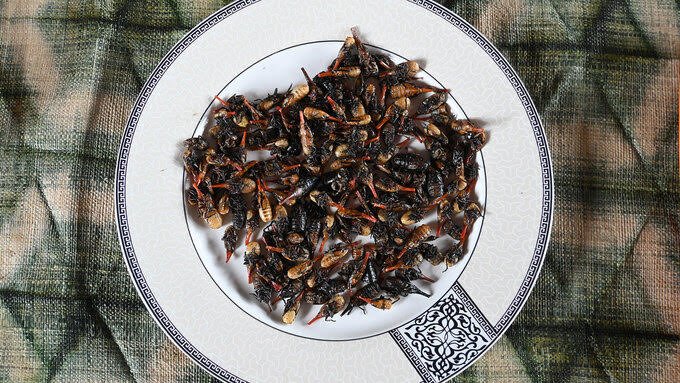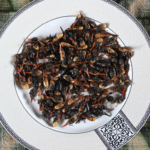With minimal investment and resources needed, Sakondry farming creates income opportunities, especially for rural women, who are taking the lead in managing production.
The ambition is that in the future, Sakondry farming can be expanded, and the insects could be sold nearby, therefore providing additional income to families.
The post This bug bacon is saving the lemurs appeared first on Green Prophet.
Bug bacon
Let them eat bugs!
It tastes a bit like bacon when you fry it, and it’s affordable and packed with protein. Meet the Sakondry (Zanna tenebrosa), a tiny jumping insect that has been a popular snack for hundreds of years, mainly in the rural areas of Madagascar’s east coast.
But it’s more than just a tasty treat and a booster for food security. With the help of the Sustainable Wildlife Management (SWM) Programme, these edible insects are also an innovative solution and potential game changer in helping to take the pressure off and preserve Madagascar’s endangered and distinctive primates – lemurs.
The SWM Programme, implemented by the Food and Agriculture Organization of the United Nations (FAO) works to restore the balance between food security and wildlife conservation, especially consequential to Madagascar’s unique habitats.
The lemur enjoys protected status under Madagascar’s wildlife laws. However, around the remote villages in the country’s northeastern Makira Natural Park in the Analanjirofo region, this primate continues to be hunted for meat, putting its survival at risk. Wild meat, including lemurs, can account for up to 75 percent of local people’s protein and 14 percent of people’s iron intake in this part of Madagascar.
Sakondry offer a nutritious and sustainable alternative, helping to safeguard Madagascar’s lemurs. There’s just one problem: populations of the Sakondry itself, once abundant, have also declined, causing concern among local residents.
Climate change, forest and biodiversity degradation as well as dwindling rainfall have all conspired together to create an environment that’s fast becoming too dry for the Sakondry’s comfort.
Another challenge is that, according to field surveys, communities were harvesting the insects without accounting for their reproductive cycle, negatively impacting their numbers. Ideally, only larvae that have reached a certain developmental stage should be collected, avoiding the capture of breeding adults, which are already winged and easily recognizable.
Now, drawing on the innovative research of anthropologist and conservation biologist, Cortni Borgerson, the Programme has launched a community-based insect farming initiative.
Instead of communities relying on catching Sakondry in the forest, the initiative has introduced the production of lima beans (Phaseolus lunatus), called tsidimy by locals and a favourite with the Sakondry, which flock to feed on the bean plants’ sap.
Tsidimy, as a legume, is also a remarkable asset for sustainable agriculture. It enriches the nitrogen in the soil and reduces erosion. This nature-based solution offers a dual benefit: it ensures a steady supply of protein coming from both Sakondry and beans.
Sakondry insects in themselves are exceptionally nutritious, rivaling traditional protein sources. Per 100 grams, they contain 20.1 grams of protein, comparable to chicken, pork and beef. They also provide considerably more potassium, calcium and iron than traditional animal proteins. Add the protein and micronutrients from the beans into the equation and you have a substantial contribution to a communities’ nutrition.
With minimal investment and resources needed, Sakondry farming creates income opportunities, especially for rural women, who are taking the lead in managing production. The ambition is that in the future, Sakondry farming can be expanded, and the insects could be sold nearby, therefore providing additional income to families.
Scaling up this practice exemplifies how using nature-based solutions and reviving local traditions can address both human needs and conservation goals in Madagascar’s unique ecosystem.
The post This bug bacon is saving the lemurs appeared first on Green Prophet.
Recommended Story For You :

Bringing Dead Batteries Back To Life Is Simple!

SEPTIFIX to the Rescue! Say Goodbye to Problems and Hello to Savings

Ecomposing of Paper Towels Produce Methane Gas

A Leading Cause Of Global Warming!

A cleaner world where energy is abundant essentially free

and sourced directly out of the inherent power of the space surrounding us.

MIT Discovery can cut power bills by 65%

Easy DIY Power Plan Will Change Our World Forever

Discover the World with Our Passionate Geography Teacher in Memphis!




